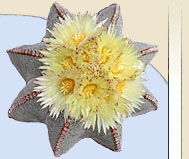 |
 |
CULTIVAR / КУЛЬТИВАР e-Magazine about exotic forms of Cactaceae ENGLISH / RUS-(Win1251) | |||||
| Start page | Authors | Articles | Photogallery | Search | Links | Guestbook | Project by Valery Kalishev |

|
By Petr Lapshin, Ph.D., Moscow Short-wave ultraviolet radiation of quartz lamps does not only cause damage but also mutations as UV-rays target DNA – the storage of hereditary information. Such influence may have sense if we deal with callus culture because in such a tissue every cell in theory may start a plant and it can be regarded as an individual organism, and the whole callus tissue as a colony of independently propagating unicellular organism. This method has obvious advantages as compared with traditional selection where we target either gametes or meristems. As for treating seedlings with usual UV-lamps I am skeptic about it as ultraviolet is a factor that influences only the surface and is absorbed by the upper layers of cells. In cactus meristem propagating cells are not on the surface, so, they are defended well from ultraviolet. So if the doses are not lethal they will lead only to the damage of the cuticle that are burns which will not cause variegated forms or crests. This is just theory. Radioactive isotopes penetrate deep into the tissues and cause damages of DNA which lead to mutations is the reparation of the damage goes wrong. Mutations in tissues that divide actively, for instance in meristems, will lead to chimerical, including variegated, forms. If such a tissue will form flowers syngenesis will be possible and new forms of plants may be got. |
|
Copyright © Valery Kalishev, Chelyabinsk, Russia, 2000-2005
Design and hosting - Peter Lapshin, 2002-2005 |